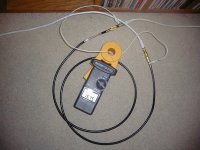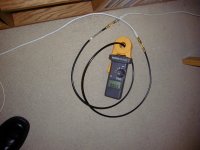PLC is EMC and has an Ofsted exclusion in the UK because it is EMC so you cant remove it, it should be banned, just another source of noise to contend with...
HF RF noise is fun to keep out or in
Technically it fails EMC, Ofcom ignored it because BT sell it -- invoking the "we only get a handful of complaints" excuse. But I don't think Ofsted care at all
RSGB have spent ages trying to get sense to prevail, as far as we got was spectral notches for amateur radio bands and a few other areas....
With the PLC networking adaptor running, I had 20 mV pi-pk at 23 MHz on the pre output without the X cap across the mains 50mV pk-pk. I did not try a CM clamp on choke on the mains cable.
My interim solution was to turn the PLC off.
What does that 23MHz sound like?
But seriously, it'd be ok if it wasn't modulated... I used to find myself humming the GSM LF modulation envelope...
What does that 23MHz sound like?
But seriously, it'd be ok if it wasn't modulated... I used to find myself humming the GSM LF modulation envelope...
I will solve it 'proper like'
However, 23 MHz running around the internals of a pre cannot be a good thing. As you note, its easy for that stuff to couple and for it to be modulated by the audio signal so it gets messy pretty quickly.
Has anyone tried the Johanson Surface mount X2Y caps for cleaning up the RF grot on inputs?
EMI Filters.
Of course at some point you need to encase the input circuitry and use feedthroughs. Another std technique outside the high end
EMI Filters.
Of course at some point you need to encase the input circuitry and use feedthroughs. Another std technique outside the high end
Technically it fails EMC, Ofcom ignored it because BT sell it -- invoking the "we only get a handful of complaints" excuse. But I don't think Ofsted care at all
RSGB have spent ages trying to get sense to prevail, as far as we got was spectral notches for amateur radio bands and a few other areas....
EMC club UK have an ongoing campaign against it but offcom ignore it, as they did with my complaint.... and many others.
Has anyone tried the Johanson Surface mount X2Y caps for cleaning up the RF grot on inputs?
EMI Filters.
Of course at some point you need to encase the input circuitry and use feedthroughs. Another std technique outside the high end
Yes and other techniques, quite a few schemes in fact.....
Yes and other techniques, quite a few schemes in fact.....
Would be interesting to discuss what are the pragmatic practices for I/O whilst we are vaguely on topic
Whitlock has opined that the great advantage of power conditioners comes from people plugging equipment with safety grounds into the same box.
He is correct.
Connection of the safety grounds at a common point will protect against lightning induced transients which will blow interconnect circuitry.
Another thing that is (or should be) required is the connection of all the input grounds, as in a multiport SPD. This to protect against the cable run induced voltages from a near strike, or even cloud to cloud.
John
Yes.Can I clarify 'common point'? I have a 12 way workbench power strip that used to do duty on an assembly line with a single 13A plug on the end. Does that count as a common point given the internal grounds are daisy chained?
When a nearby strike hits, there will be a time varying magnetic field expanding cylindrically from the bolt. Any loop of wire that traps it will generate a voltage around the loop. Your workbench strip does not have a large loop area for trapping.
If for example, your tv power romex comes up one side of the house, and your cable comes up the other, you are ripe for disaster, it'll frost your inputs if a nearby strike happens. A multiport will prevent that.
John
I must be being thick ( as usual) as having them in series does really seem to be leveraging the worst of both, so you have the slow response of the GDT and the low power handling of the MOV combined, rather than using the positives.
I said the lightning at the building entrance has a slower Tr than the GDT response time. You can also add a small amount of filtering before the GDT and make sure the speed is adequate. I use a ferrite wound in CM (all 3 wires) before coming into the protection device(s).
What is the test gear transient used to test surge protection products --- see UL1449.
THx-RNMarsh
Last edited:
There are several problems for audio in the home. EMI/RFI is but one. Grounding is another. Until recently, our NEC (National Elec Code) said it was OK to just put a safety ground wire in the earth at the point of cable entry.... cable being Telephone, or CATV etc. This gives us a multiple ground point system instead of a single point ground. Recently, the NEC caught up and requires all cable entry and ground at one point where ac power is grounded.
So, the majority of us have a multiple ground which causes ground loop currents to flow.
Here is shown, the 60Hz power current flowing thru a CATV cable.... the CATV is grounded about 100 feet from the ac power panel ground. There is enough earth resistance to develop a voltage between the two different points. One is the mA current flowing in the CATV cable and the other with the ground side of the CATV cable coupled with a small C.... small enough to be a high Z to 60Hz.


The mA current flow is rather higher than you might have thought. The problem shows itself when a Video and Audio system are connected together.... hum, noise or increased distortion results. This grounding situation is the norm in USA unless you have a home built in the last couple years.
THx-RNMarsh
So, the majority of us have a multiple ground which causes ground loop currents to flow.
Here is shown, the 60Hz power current flowing thru a CATV cable.... the CATV is grounded about 100 feet from the ac power panel ground. There is enough earth resistance to develop a voltage between the two different points. One is the mA current flowing in the CATV cable and the other with the ground side of the CATV cable coupled with a small C.... small enough to be a high Z to 60Hz.


The mA current flow is rather higher than you might have thought. The problem shows itself when a Video and Audio system are connected together.... hum, noise or increased distortion results. This grounding situation is the norm in USA unless you have a home built in the last couple years.
THx-RNMarsh
Last edited:
Luckily UK is generally better, except when I was on a poor overhead power line that was tripping an 80mA RCD regularly.
But if your cable box is double insulated (as many TVs and disk players are as well) with no PE, then where does this current come from? Whilst a proper equipotential bonding setup is the 'right way' it seems this issue should have an easy fix?
But if your cable box is double insulated (as many TVs and disk players are as well) with no PE, then where does this current come from? Whilst a proper equipotential bonding setup is the 'right way' it seems this issue should have an easy fix?
There are several problems for audio in the home. EMI/RFI is but one. Grounding is another. Until recently, our NEC (National Elec Code) said it was OK to just put a safety ground wire in the earth at the point of cable entry.... cable being Telephone, or CATV etc. This gives us a multiple ground point system instead of a single point ground. Recently, the NEC caught up and requires all cable entry and ground at one point where ac power is grounded.
THx-RNMarsh
I use these often.
DENO - Ground wire choke, open design
Luckily UK is generally better, except when I was on a poor overhead power line that was tripping an 80mA RCD regularly.
But if your cable box is double insulated (as many TVs and disk players are as well) with no PE, then where does this current come from? Whilst a proper equipotential bonding setup is the 'right way' it seems this issue should have an easy fix?
In the US, on the east coast, we use a single bushing transformer on the pole. The ground for the multikilovolt primary feeds in the residential areas is shared by the secondary of the 120 volt, it goes into the house as a neutral. In addition, roughly every second or third pole has a copper grounding wire going into the earth.
The net result of that, is that the earth actually carries roughly 5% of the current being delivered to the residences. There is a 60 hz voltage gradient across the actual land.
There is a requirement to run a grounding rod at the meter pan on the outside of the house. the resistance value of that earth ground is required to be less than 25 ohms. If it is greater, we are required to add a second one, I believe it must be at least 8 feet from the first. There is no requirement that two rods have a parallel resistance less than 25 ohms, just that a second one be used if the first is greater than 25.
The earthing rods are NOT current fault paths for the electrical wiring of a house. They are entiirely for lightning, to be used to divert current to the earth.
On the west coast, they use two bushing transformers, and do not rely on the earth to carry sizeable currents. However, since the system still has to be brought to earth potential for strikes per NEC, they also have to contend with earth currents.
John
- Status
- Not open for further replies.
- Home
- Member Areas
- The Lounge
- John Curl's Blowtorch preamplifier part II